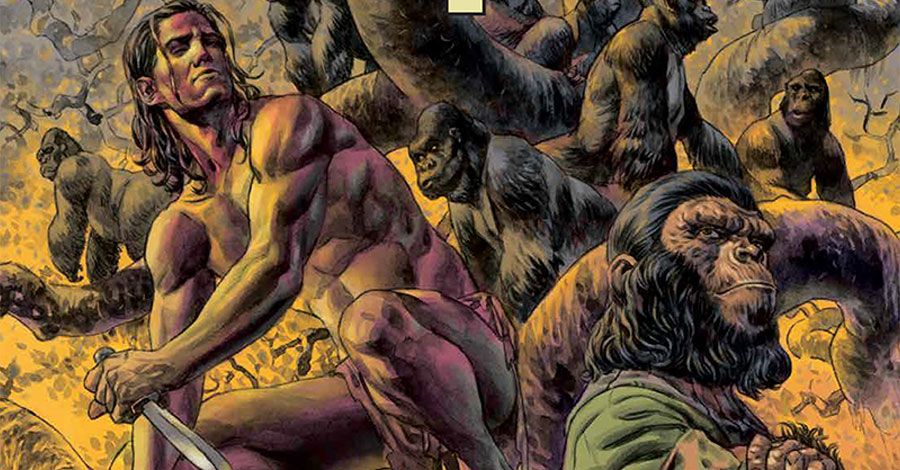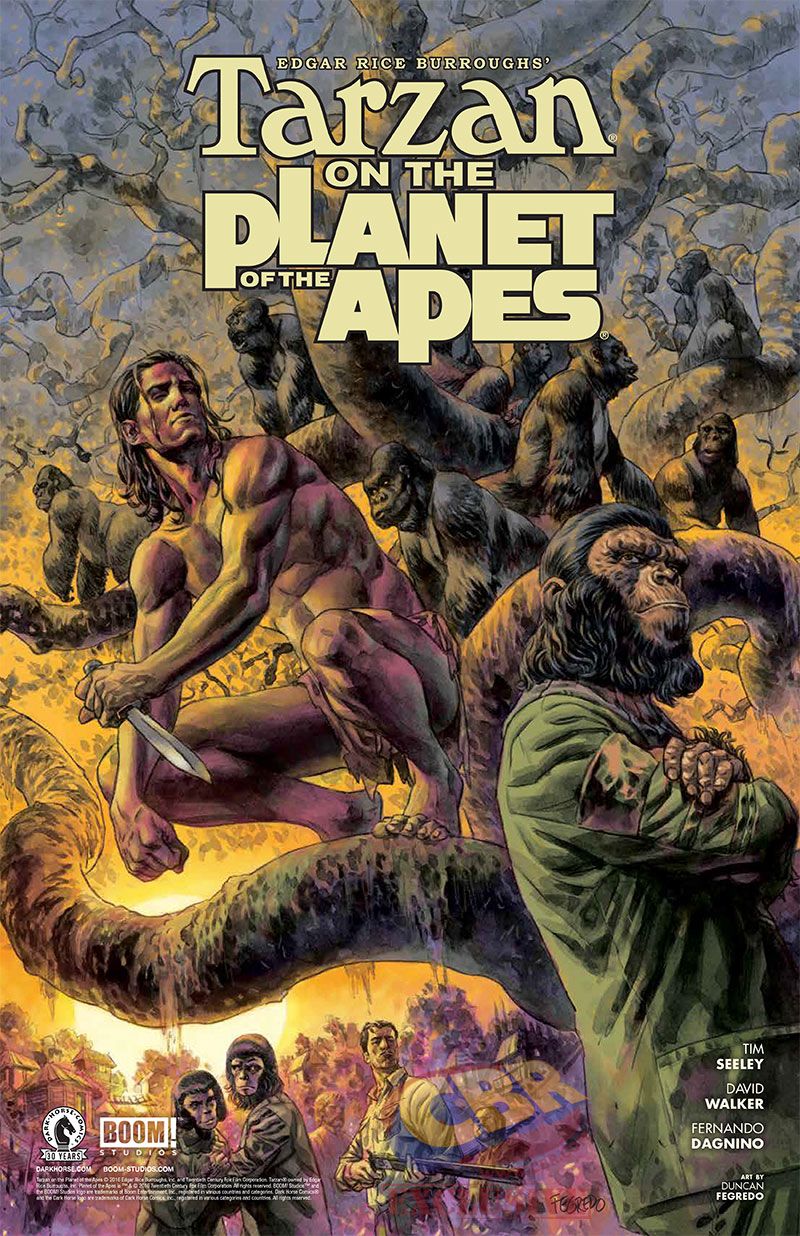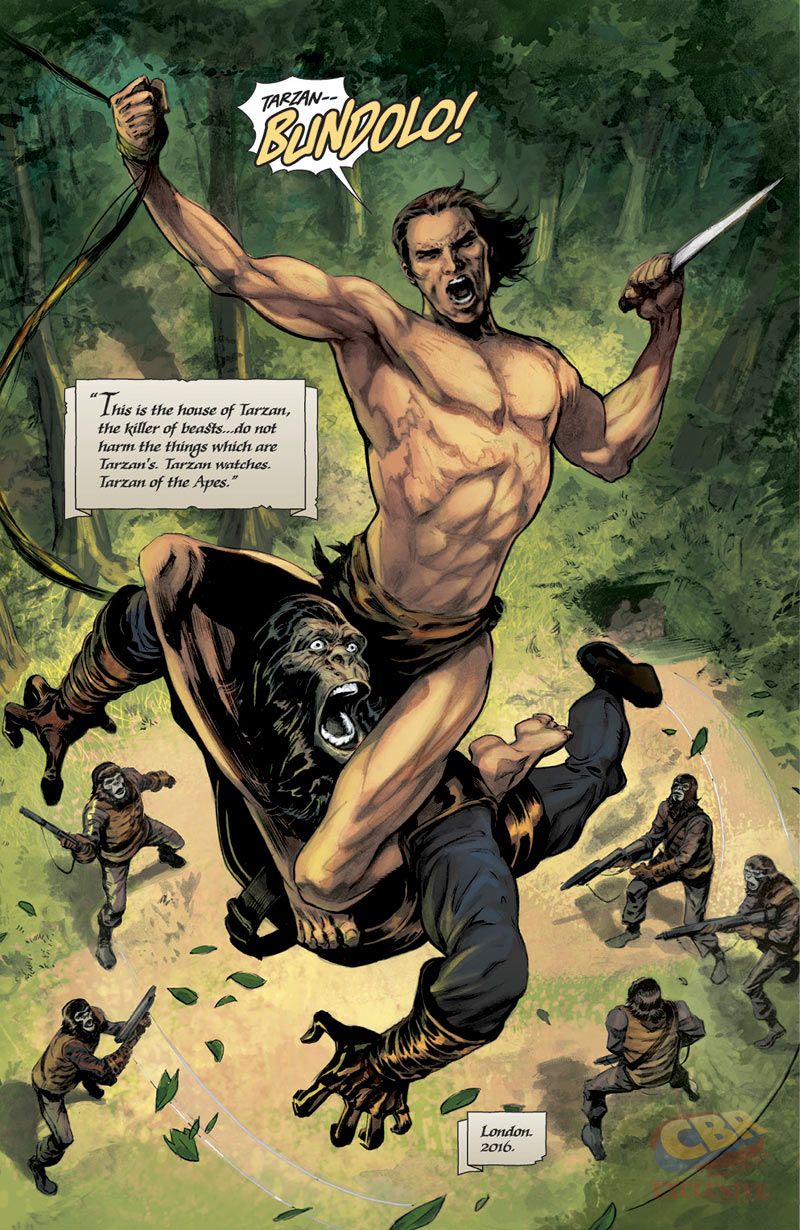Tarzan's no stranger to living with apes, but a new crossover between Dark Horse Comics and BOOM! Studios will introduce him to a new world of talking primates in "Tarzan On The Planet Of The Apes."
Announced today at Emerald City Comicon, the five-issue series, co-written by Tim Seeley and David F. Walker with art by Fernando Dagnino, features two properties with quite a bit in common. Both have roots in classic books thanks to authors Edgar Rice Burroughs and Pierre Boulle, and both have lived on in a variety of other media offerings ranging from television and film to comics and video games.
This September, the two franchises collide in a new world that finds Tarzan raised by "Planet of the Apes" mainstays Zira and Cornelius alongside their biological son Milo -- and that's just where the story begins. CBR News have the first interview with Walker and Seeley about the project, and why these two franchises work so well together.
CBR News: How does Tarzan fit into the world filled with talking apes we're familiar with from the films and comics?
Tim Seeley: The series starts with Tarzan growing up, raised by the intelligent apes, Zira and Corneilius, along with his brother Milo. It gets crazier from there.
David F. Walker: With any of these types of crossovers, it is always an issue of finding how to merge these two different worlds. Fortunately, both franchises had some interesting concepts that made things a bit easier. "Planet of the Apes" has time travel, and Tarzan has talking apes known as the Mangani. I don't want to say any more than that, because it would start getting into spoilers. But I will say that combining these franchises wasn't nearly as difficult as one might think.
One of the great things about working on classic franchises like this is the opportunity to introduce them to new characters or locales. What can readers look forward to in this series?
Walker: We bring in quite a few recognizable and classic characters, but we play around with them -- starting with Tarzan. This is not the same Tarzan you know and love, though he is very familiar. The biggest changes we see are in the POTA characters. We see a lot of them, from many of the original movies, and they are all different -- some slightly, other drastically.
There's one in particular -- I can't say without giving away a major spoiler. One of the things Tim and I did, with the help of Scott, was to create a world of Tarzan and POTA that makes sense -- at least in the classic willing suspension of disbelief sense.
Seeley: Our approach was more to mine the long legacy of these stories and use the best stuff from their long histories. We'll see Ho-Walla, Pellucidar, Victorian London, and, of course, the Planet of The Apes.
From a thematic and storytelling perspective, what makes these worlds work so well together?
Seeley: Most importantly, both stories deal with the dynamic between man and beast. At their best, I think both franchises tell us about the savagery of man and the nobility of apes, and vice versa. Plus, I mean, both feature lots of man vs. monkey action.
Walker: Both explore the differences between humanity and the savage nature of animals. Tarzan has always been about this character trying to find peace between these two different worlds. "Planet of the Apes" has always been about apes trying to be better than humans, and pretty much falling short. At the heart of POTA, there is an exploration of prejudice and oppression, which all comes into play with this story.
How has the co-writing experience been for you two? In what ways has it altered your usual process?
Walker: I really like Tim's work, and he's a great guy. There was a lot of communication back and forth, as we tried to make sure this thing wasn't one of those crossovers that never quite comes together. We worked on the plot with [Dark Horse editor] Scott Allie, and then Tim and I divided up scripting duties. Co-writing is a different beast, but Tim is easy-going, so there was never any drama. We never screamed at each other, or anything like that.
Seeley: I suggested we try a method Tom King and I used on "Grayson," wherein we talk out the ideas, and then switch off scripting every other issue. We found out as we went along that we have different ways of doing things, but that was sort of our strength in the end. We managed to cram in a lot of ideas, and bounce inspirations off each other, and with Scott.
Speaking of collaboration, what's it been like working with Fernando so far?
Seeley: We don't really work "with" him, since he's off in Italy slinging lead without us, but I can say unreservedly that the pages I've seen are really beautiful. Fernando's stuff is reminiscent of the best Tarzan artists -- John Buscema, Joe Kubert, Russ Manning and Burne Hogarth, but with a modern twist.
Walker: I know other writers say this, but it is true: If there's only one reason you buy this book, it should be for Fernando's art. I grew up reading the old black and white POTA comics, which had amazing art by guys like Mike Ploog, Rico Rival and Alfredo Alcala, and Fernando's art is right up there those guys. BOOM! Studios has done some great POTA stuff recently -- that Marc Laming stuff was absolutely beautiful. But I've got to say, as a ride-or-die "Planet of the Apes" fan that still has his Power Records book-and-records collection, Fernando's art is among the best of the best.
"Tarzan On The Planet Of The Apes" #1 by David F. Walker, Tim Seeley and Fernando Dagnino debuts in September from Dark Horse Comics and BOOM! Studios.



